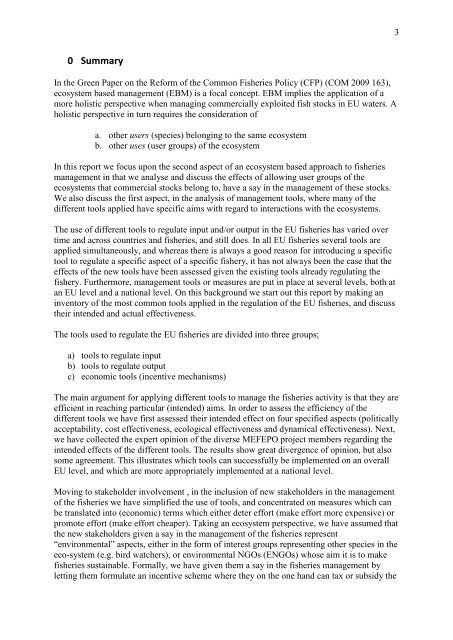Operational tools and adaptive management
Operational tools and adaptive management
Operational tools and adaptive management
You also want an ePaper? Increase the reach of your titles
YUMPU automatically turns print PDFs into web optimized ePapers that Google loves.
0 Summary<br />
In the Green Paper on the Reform of the Common Fisheries Policy (CFP) (COM 2009 163),<br />
ecosystem based <strong>management</strong> (EBM) is a focal concept. EBM implies the application of a<br />
more holistic perspective when managing commercially exploited fish stocks in EU waters. A<br />
holistic perspective in turn requires the consideration of<br />
a. other users (species) belonging to the same ecosystem<br />
b. other uses (user groups) of the ecosystem<br />
In this report we focus upon the second aspect of an ecosystem based approach to fisheries<br />
<strong>management</strong> in that we analyse <strong>and</strong> discuss the effects of allowing user groups of the<br />
ecosystems that commercial stocks belong to, have a say in the <strong>management</strong> of these stocks.<br />
We also discuss the first aspect, in the analysis of <strong>management</strong> <strong>tools</strong>, where many of the<br />
different <strong>tools</strong> applied have specific aims with regard to interactions with the ecosystems.<br />
The use of different <strong>tools</strong> to regulate input <strong>and</strong>/or output in the EU fisheries has varied over<br />
time <strong>and</strong> across countries <strong>and</strong> fisheries, <strong>and</strong> still does. In all EU fisheries several <strong>tools</strong> are<br />
applied simultaneously, <strong>and</strong> whereas there is always a good reason for introducing a specific<br />
tool to regulate a specific aspect of a specific fishery, it has not always been the case that the<br />
effects of the new <strong>tools</strong> have been assessed given the existing <strong>tools</strong> already regulating the<br />
fishery. Furthermore, <strong>management</strong> <strong>tools</strong> or measures are put in place at several levels, both at<br />
an EU level <strong>and</strong> a national level. On this background we start out this report by making an<br />
inventory of the most common <strong>tools</strong> applied in the regulation of the EU fisheries, <strong>and</strong> discuss<br />
their intended <strong>and</strong> actual effectiveness.<br />
The <strong>tools</strong> used to regulate the EU fisheries are divided into three groups;<br />
a) <strong>tools</strong> to regulate input<br />
b) <strong>tools</strong> to regulate output<br />
c) economic <strong>tools</strong> (incentive mechanisms)<br />
The main argument for applying different <strong>tools</strong> to manage the fisheries activity is that they are<br />
efficient in reaching particular (intended) aims. In order to assess the efficiency of the<br />
different <strong>tools</strong> we have first assessed their intended effect on four specified aspects (politically<br />
acceptability, cost effectiveness, ecological effectiveness <strong>and</strong> dynamical effectiveness). Next,<br />
we have collected the expert opinion of the diverse MEFEPO project members regarding the<br />
intended effects of the different <strong>tools</strong>. The results show great divergence of opinion, but also<br />
some agreement. This illustrates which <strong>tools</strong> can successfully be implemented on an overall<br />
EU level, <strong>and</strong> which are more appropriately implemented at a national level.<br />
Moving to stakeholder involvement , in the inclusion of new stakeholders in the <strong>management</strong><br />
of the fisheries we have simplified the use of <strong>tools</strong>, <strong>and</strong> concentrated on measures which can<br />
be translated into (economic) terms which either deter effort (make effort more expensive) or<br />
promote effort (make effort cheaper). Taking an ecosystem perspective, we have assumed that<br />
the new stakeholders given a say in the <strong>management</strong> of the fisheries represent<br />
“environmental” aspects, either in the form of interest groups representing other species in the<br />
eco-system (e.g. bird watchers), or environmental NGOs (ENGOs) whose aim it is to make<br />
fisheries sustainable. Formally, we have given them a say in the fisheries <strong>management</strong> by<br />
letting them formulate an incentive scheme where they on the one h<strong>and</strong> can tax or subsidy the<br />
3

















